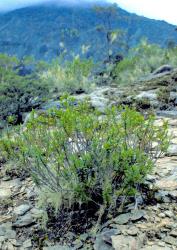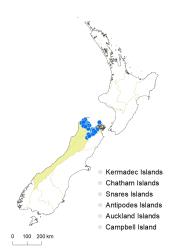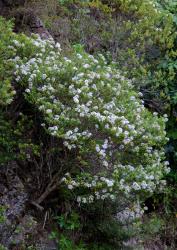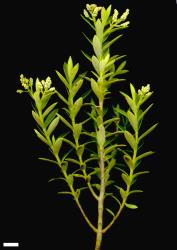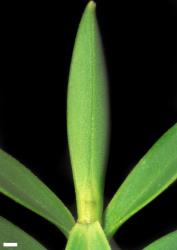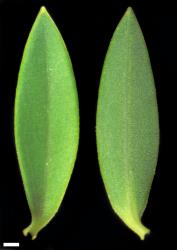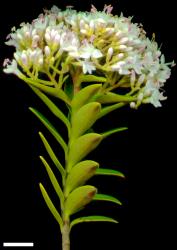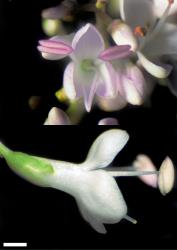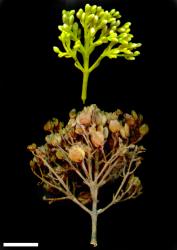- ≡ Hebe subfulvida G.Simpson & J.S.Thomson, Trans. & Proc. Roy. Soc. New Zealand 73: 163 (1943)
- = Veronica menziesii var. divaricata Cheeseman, Man. New Zealand Fl. 512 (1906)
- ≡ Hebe divaricata (Cheeseman) Cockayne & Allan, Trans. New Zealand Inst. 56: 20 (1926)
- = Hebe corymbosa G.Simpson, Trans. Roy. Soc. New Zealand 79: 428 (1952)
Bushy shrub to 1.8 m tall. Stems spreading to erect, eglandular-puberulent; hairs usually bifarious, sometimes uniform. Leaf bud distinct, its leaves appressed at margins until fully grown; sinus acute. Leaves opposite-decussate or sometimes sub-distichous, erecto-patent to spreading; lamina coriaceous or rigid, lanceolate to elliptic (usually narrowly), sometimes oblanceolate, 6–39 mm long, 2.5–7.5 mm wide, dull or glossy, green or dark green above, paler beneath, midrib evident; surfaces glabrous or eglandular hairs along midrib above; margin glabrous and minutely papillate or minutely antrorse ciliolate, entire; apex acute to acuminate or weakly plicate-acuminate; base cuneate; petiole 0.8–4.5 mm long. Inflorescence a lateral, usually compound, occasionally ternate or simple, raceme, 10–60 mm long; flowers crowded, 24–88, all bisexual; bracts alternate or sometimes the lowermost opposite, lanceolate to ovate to oblong, usually >, sometimes ≤ pedicels; pedicels erect to erecto-patent, 0.5–4.0 mm long, usually shortly eglandular-hairy all around, sometimes almost glabrous. Calyx lobes 4–5, 5th lobe small, posterior, obtuse to sub-acute, occasionally emarginate, 1.5–2.0 mm long, sub-equal, mixed glandular- and eglandular-ciliolate. Corolla 6–10 mm diameter; tube white, 2.1–4.3 mm long, >calyx, hairy inside; lobes 4, white, pink, or pale purplish, sub-erect to spreading, sub-equal, elliptic to ovate to sub-orbicular, 2.5–4.5 mm long, obtuse; nectar guides absent. Stamen filaments white or pink, 3.5–5.5 mm long; anthers pink or pale purplish; style glabrous, 4.5–8.5 mm long. Capsules latiseptate, acute, glabrous, 2.9–4.5 mm long, 1.9–3.2 mm at widest point. Seeds broad ellipsoid to discoid, flattened, smooth, dark brown or orange-brown, 1.2–2.0 mm long.
Most plants of V. subfulvida can be recognised by the narrow leaves and dense, compound racemes. In these features they resemble V. diosmifolia plants, which may be distinguished by their usually incised leaf margins, some flowers on every plant having the anterior calyx lobes fused for some or all of their length, and their distribution in the northern North Island.
In Marlborough the distinction between V. brachysiphon and V. subfulvida becomes unclear, but, in general, plants with simple inflorescences and stout elliptic leaves are determined as V. brachysiphon, while those with branching inflorescences and thinner, narrowly elliptic leaves are determined as V. subfulvida. The two differ in chromosome number. Some specimens of V. subfulvida with unusually broad leaves and simple inflorescences may be hard to distinguish from V. brachysiphon, but unbranched inflorescences are rare and on every plant some inflorescences are branched.
V. baylyi plants have more glaucescent leaves than V. subfulvida plants, unbranched inflorescences, and their corolla tubes are glabrous.
Plants of V. brachysiphon and V. venustula have broader leaves, simple or rarely tripartite inflorescences, and different chromosome numbers; also V. venustula plants are found only in the North Island and V. brachysiphon mostly occurs in south and east Marlborough and in Canterbury.
Plants of V. subfulvida can frequently be found growing with V. leiophylla, which can usually be distinguished by the uniformly puberulent stems, simple and often longer inflorescences, and short, broad, leaf bud sinus.
South Island: Western Nelson (northern parts), Sounds Nelson (Rangitoto ki te Tonga / D’Urville I., western ranges), Westland (Nelson Lakes National Park only).
Rock outcrops and gorges, scrub and forest margins, lowland to montane, occasionally sub-alpine. Recorded elevations range from 10 to 1300 m.
It is possible that some of the variation might be explained by hybridisation, e.g., with V. baylyi on the mineral belt of the Richmond Range and Bryant Range of Nelson, and perhaps with V. brachysiphon in Marlborough.
Flowers: December–February (occasionally March); fruits: January–May, persisting to October.
2n = 80 (see Bayly & Kellow 2006, as Hebe divaricata).
Veronica subfulvida is classified in V. subg. Pseudoveronica sect. Hebe and the informal group “Apertae” (small-leaved) (Albach & Meudt 2010; Bayly & Kellow 2006).
Plants in north-west Nelson are generally larger and have large, extensively branched inflorescences. Plants in the Richmond Range and Marlborough Sounds can have sparingly branched inflorescences and are then sometimes difficult to distinguish from V. baylyi and V. brachysiphon.



